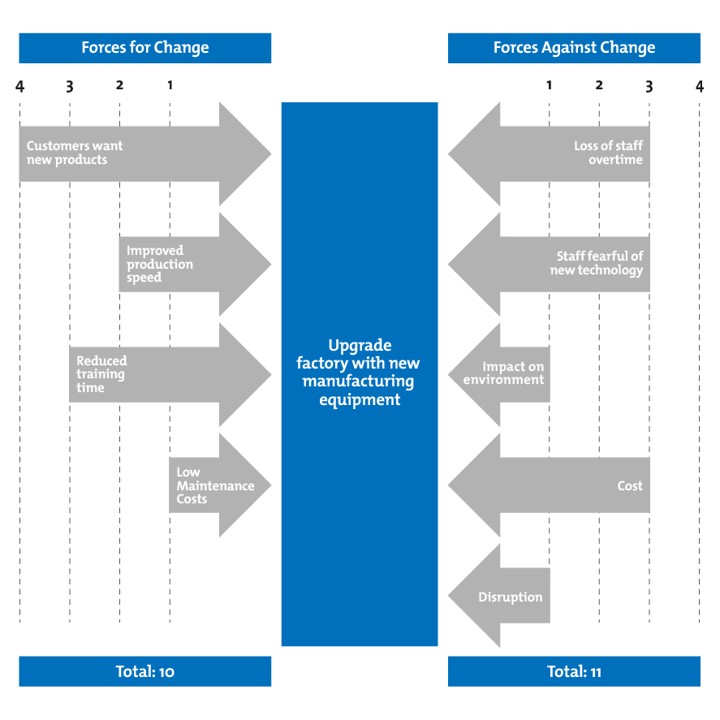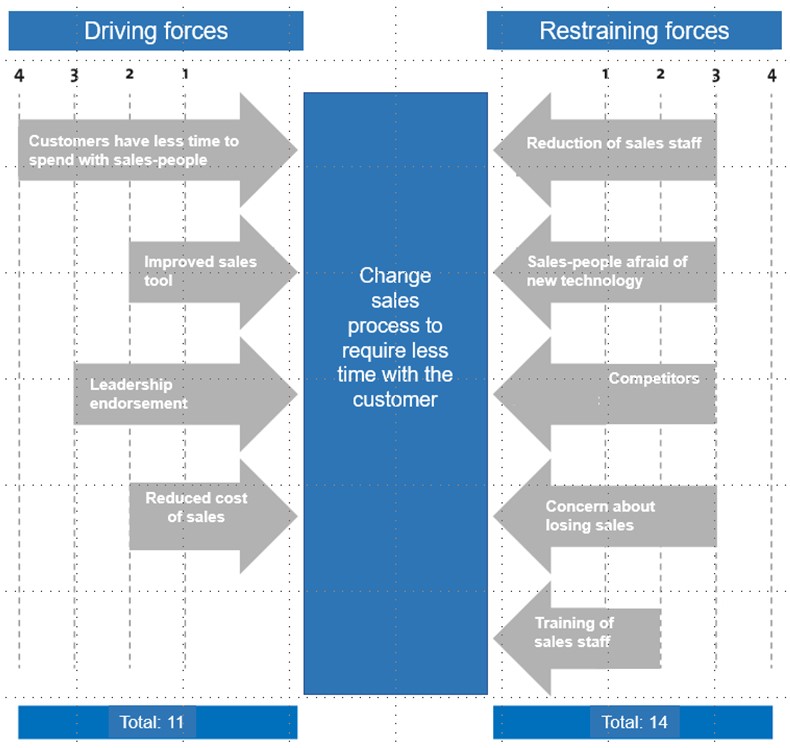
Some changes in your organization go smoother than others. Sometimes there is resistance to the changes which must be overcome for the change to occur. Force field analysis identifies and analyzes those forces which help drive change and those which restrain or inhibit change. Let’s learn more about those forces and how to manage them to assure your organization can implement needed change without disruption and delays.
Overview: What is a force field analysis?
In simple terms, force field analysis is a framework for understanding the factors which can influence and impact a potential change. This change can be associated with an individual, organizational, or improvement project. For change to happen, the driving (helping) forces must be strengthened, or the resisting (hindering) forces weakened.
The model was originally developed by social psychologist Kurt Lewin, who described the individual change process as a balance between two types of forces – those that are driving movement toward a goal (helping forces) or are blocking movement toward a goal (hindering forces). His theory was expanded by John R. P. French who applied it to organizational and industrial settings.
Here are the steps for completing a force field analysis:
1. Describe and clarify the proposed change and write it in a box in the center of the page.
2. Brainstorm and identify the driving or helping forces for change.
These may include such internal or external things such as:
- Outdated machinery or product lines.
- Declining organizational morale
- A need to increase profitability
- Uncertain operating environment
- Engaged organizational leadership
- Changing demographic and competitive trends
3. Brainstorm and identify the blocking (resisting or hindering) forces to change.
These may include such things as:
- Fear of the unknown
- Existing organizational structures
- An attitude of That’s not how we do things around here
- Current commitments to other organizations
- Government regulations
- Existing customer obligations
- Uncommitted or uninvolved leadership
- Too busy to do it
- Negative outcomes from prior attempts at change
- No champion for the change
4. Score and weight each factor.
You can score each factor from one (weak) to five (strong), based on the degree of influence each one has on the change. Add the scores up for the driving and resisting forces. For a simple visual presentation, you can use the length of arrows to show the relative strength of each factor. The figure below is an example of what your force field analysis might look like at this point.

Example of force field analysis
5. Analyze and implement your action plan for change.
Decide which of the forces have some flexibility for change or which can be influenced. Create a strategy to strengthen the driving forces or weaken the restraining forces, or both. If you’ve rated each force, how can you raise the scores of the driving forces or reduce the scores of the restraining forces, or do both?
What action steps can you take that will achieve the greatest impact? Identify the resources you will need and decide how to implement the action steps. Sometimes it’s easier to reduce the impact of restraining forces than to strengthen driving forces.
3 benefits of a force field analysis
Here are a few of the benefits of using a force field analysis to improve your probability of a successful change in your organization.
1. Reduces barriers to change
Understanding the forces driving or hindering your desired change can help identify what forces are preventing forward movement and what is needed to overcome those barriers.
2. Creates effective communication
Attitudes and mindsets are common restraining forces in many organizations. Having an open and honest discussion of why certain things are considered restraining forces, will help your management understand the nature of those emotions and help create more effective communication of the proposed changes.
3. Reduces resistance to change
Employee resistance is a common obstacle to change, and often appears as one of the restraining forces in a force field analysis. Understanding the reasons for that resistance can help you develop appropriate strategies for reducing it.
Why is a force field analysis important to understand?
Understanding the importance and purpose of a force field analysis will help you utilize this powerful tool to optimize your implementation of change in your organization.
The existence of specific forces which will help or hinder change
Organizations are often aware of the negatives which may impact a desired change. But there are also positives which will help facilitate and drive your change. These must be identified and used.
Provide insight into why people may resist your change
While resistance to change is a well-known factor impacting any change process, you need to understand what the underlying reasons for this resistance are.
Flexibility of the force field analysis
This tool can be used to assess a macro change affecting a group of people as well as at the individual level.
An industry example of a force field analysis
As a result of some marketing research, the Vice President of Sales and Marketing formed a Six Sigma improvement team to explore changing the sales process to reduce the time sales-people spend with their customers. Before implementing the recommendations, the team’s Black Belt suggested they do a force field analysis to better understand the possible barriers to a successful implementation of the changes. Below is their analysis.

As you can see, the value of the restraining forces is greater than the driving forces. This change will fail unless the driving forces are strengthened and/or the restraining forces are weakened.
3 best practices when thinking about a force field analysis
Doing a force field analysis is a relatively straightforward process. Use the following tips to help you keep things simple yet constructive.
1. Formalized brainstorming
Conduct formal, structured brainstorming to identify the driving and restraining forces which will impact how well your desired change will work.
2. Be realistic
When analyzing your driving and restraining forces, be realistic as to your options for strengthening your driving forces while weakening your restraining forces.
3. Do your force field analysis early in the Improve phase of DMAIC
Developing your force field analysis, possibly along with an FMEA, will let you mitigate resistance prior to implementation of your proposed changes.
Frequently Asked Questions (FAQ) about a force field analysis
What are the components of a force field analysis?
According to Lewin, there are four components of force field analysis: driving forces, restraining forces, forces for change, and the forces resisting change.
When would you use a force field analysis?
Force field analysis is used to identify which factors, when attempting to make a change, drive a person or organization towards or away from a desired state. It is also used to identify the forces which cause people or the organization to resist or restrain the desired change.
How would you describe how to do a force field analysis in simple terms?
- Describe the desired change project or desired state
- Identify driving or helping forces
- Identify restraining or hindering forces
- Analyze the two opposite types of forces
- Develop actions to strengthen driving forces while weakening hindering forces
Quick review of a force field analysis
Force field analysis, as developed by Kurt Lewin, helps you consider the forces for and against a decision or a change.
To do a force field analysis, you first need to describe and clarify your proposed change. You can write that in a box in the center of your form. Then, list all of the driving forces for change in a column on the left-side, and all of the restraining or blocking forces against change in a column on the right-side.
Develop a scoring scheme for each factor, and add up the scores for each column. You can then decide whether you want to move forward with the change or to change the balance of your forces to get a positive outcome for your desired change. You can use your analysis to develop a strategy and action plan so you can strengthen the forces that support the change and weaken the forces opposing it.